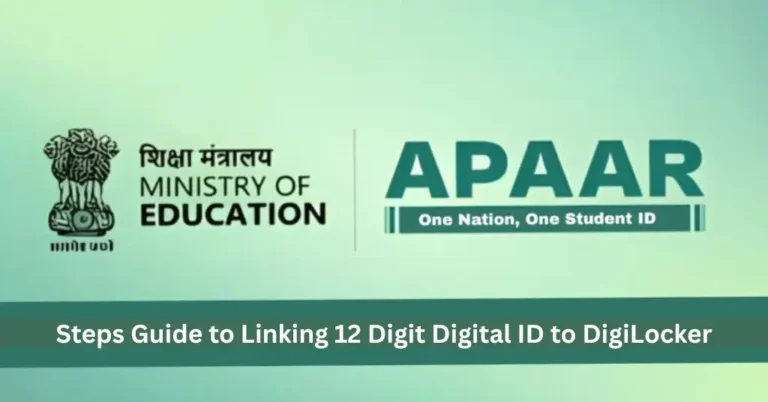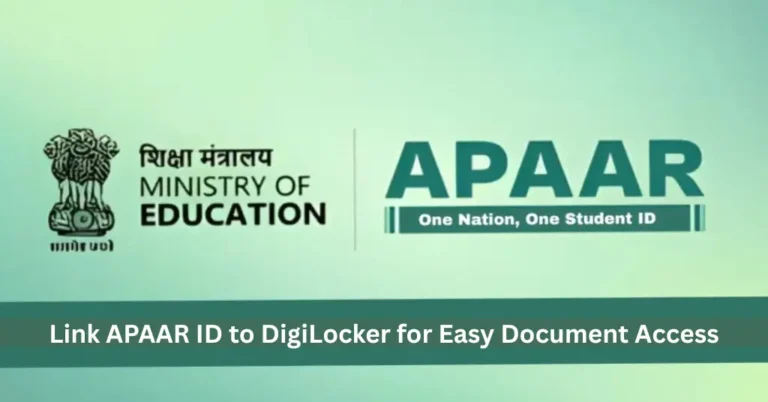APAAR ID and Its Role in Streamlining Student Data A Game Changer or Challenge The Automated Permanent Academic Account Registry (APAAR) ID, introduced under India’s National Education Policy (NEP) 2020, aims to revolutionize how student information is stored and accessed. But is it truly a game-changer, or does it present new challenges.
APAAR ID is a unique 12 digit identifier assigned to each student
It consolidates all academic records, including marksheets, degrees, and co-curricular achievements, into a digital format. This ID is linked to the student’s DigiLocker account, allowing for secure and easy APAAR ID Simple Fast in 2025.
APAAR ID Work
Verification: Students visit their school to verify demographic details.
Parental Consent: For minors, obtaining parental consent is mandatory.
Authentication: The school authenticates the student’s identity.
ID Creation: Upon successful verification, the APAAR ID is generated and added to the student’s DigiLocker account.
Benefits of APAAR ID
Centralized Data Management: All academic records are stored in one place, reducing paperwork and administrative burden.
Seamless Transitions: Students can transfer schools or apply for higher education without the hassle of managing physical documents.
Enhanced Security: Digital records are less prone to loss or damage and can be easily updated.
Integration with Other Systems: APAAR ID is linked with the Academic Bank of Credits (ABC), facilitating credit transfer and recognition across institutions.
APAAR ID Will Revolutionize India Education System
The APAAR ID is part of India’s larger vision to digitalize the education system. With digital records, students will have more control over their academic history, reducing the need for paper-based processes
This shift will not only help in organizing student data but also streamline admissions, transfers, and job placements, creating a more transparent and efficient educational ecosystem.
.
The Role of APAAR ID in Higher Education
One of the most significant benefits of the APAAR ID system is its role in higher education. Universities and colleges can easily access students’ academic records, ensuring smooth admissions and credit transfer processes
Additionally, with the Academic Bank of Credits (ABC) linked to APAAR, students can accumulate credits from different institutions, enabling a flexible and diverse learning experience.
Challenges and Concerns Is It All Smooth Sailing
Despite its promising features, the APAAR ID system has raised a few concerns. Critics point out the risks associated with data security and privacy.
Additionally, the lack of digital infrastructure in rural and remote areas could hinder widespread adoption, leaving many students behind in the race toward digital education.

APAAR ID Truly a Game Changer or a Challenge
While APAAR ID brings exciting possibilities for improving student data management, it will only be a game-changer if it addresses existing challenges effectively.
Its success hinges on overcoming privacy concerns, ensuring data accuracy, and providing equal access to all students, regardless of their location or socio-economic background.
Quick Tips for Students and Parents
Ensure that all personal details in the UDISE+ portal and Aadhaar are accurate to avoid discrepancies during the APAAR ID generation process.
Keep track of school notifications regarding APAAR ID registration and deadlines.
For minors, ensure that parental consent forms are filled out and submitted promptly.
Utilize DigiLocker to access and manage your academic records securely.
What is the difference between APAAR ID and Aadhaar?
APAAR ID is specific to students and helps store their academic records digitally. While Aadhaar is a unique identification number for individuals, the APAAR ID is focused solely on academic and educational data.
Can students from any school get an APAAR ID?
Yes, as long as the school is registered under the UDISE (Unified District Information on School Education) system and complies with the necessary regulations, students can receive their APAAR ID.
What happens if there’s a mistake in the students academic records linked to APAAR ID?
Mistakes in academic records can lead to issues in the generation of the APAAR ID. In such cases, students and parents can approach the school administration for corrections to be made through the appropriate channels.
Is APAAR ID mandatory for students in India?
While the APAAR ID is not yet mandatory, it is highly encouraged for streamlining the academic data management process. It will become increasingly important as more educational institutions adopt it.
How can students access their APAAR ID and academic records?
Students can access their APAAR ID and academic records through their DigiLocker account. The DigiLocker app can be downloaded on smartphones, and students can log in to view and manage their educational documents.
Final Words
The APAAR ID is a monumental step towards digitizing India’s education system. While there are some concerns about privacy and implementation, its potential to simplify student data management and enhance the higher education experience is undeniable.
As we move forward, ensuring proper infrastructure, privacy safeguards, and inclusivity will key to realizing the true benefits of this system.By staying informed and proactive, students and parents can take full advantage of the APAAR ID system, making their educational journey smoother, faster, and more secure





